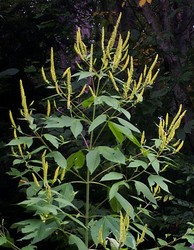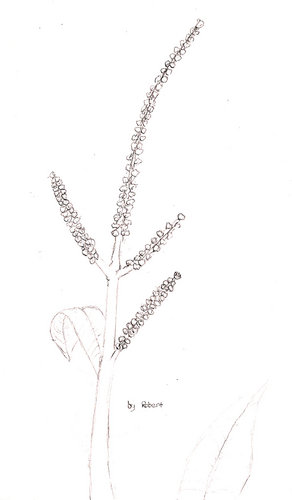Lakota name: caŋĥlóĝaŋ paŋśpaŋjela (means bulky weed seeds) Listen to Lakota Plant Name: caŋĥlóĝaŋ paŋśpaŋjela
Listen to Lakota Plant Name: caŋĥlóĝaŋ paŋśpaŋjela
Scientific name: Ambrosia trifida
Common name: Giant ragweed
Medicinal uses: The leaves are very astringent, it is an emetic and febrifuge. It is put onto insect bites, and other skin complaints. It is also a tea for the treatment of pneumonia, fevers, nausea, intestinal cramps, and diarrhea. The juice of ground leaves is a disinfectant and it is applied to infected toes. Tea made from the roots is used for menstrual disorders and stroke. The pollen is harvested commercially and used as a pharmaceutical for the treatment of allergies to the plant allergens. The pollen from Ambrosia trifida is a major cause of hay-fever and other allergies.
Edible uses: The plant was cultivated by the Columbian Indians. An oil is used from the seed. Seeds found in historic sites are 4-5 times bigger than today's. It was eaten because the seed has up to 19% oil and it is better at drying than soybean oil.


Ambrosia trifida. © 2005 zen Sutherland
Description: Giant ragweed is indigenous to North America. It can be found in every state in the continental U.S. except Nevada, and is also widespread in Canada. It flowers July- September, it has yellow flowers and lives in low woods along rail roads/roads. It forms huge colonies when it is left undisturbed. Giant ragweed is different-looking than common ragweed, Ambrosia artemisiifolia. Ragweeds are responsible for ragweed allergies. Under the right conditions giant ragweed can get 15 feet tall or more. The plant can be thicker than a broom handle and can have big branches.
Words to know:
- astringent–meaning sharp
- emetic–an agent that causes vomiting
- febrifuge–a drink to reduce fever




 Go to quick links
Go to quick search
Go to navigation for this section of the ToL site
Go to detailed links for the ToL site
Go to quick links
Go to quick search
Go to navigation for this section of the ToL site
Go to detailed links for the ToL site